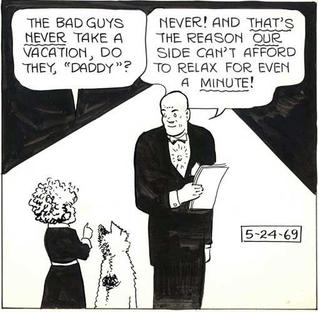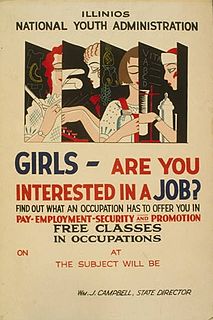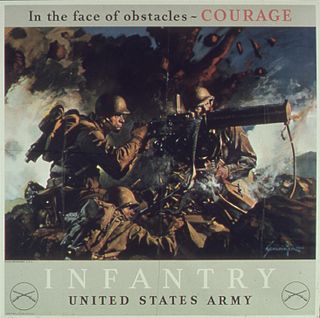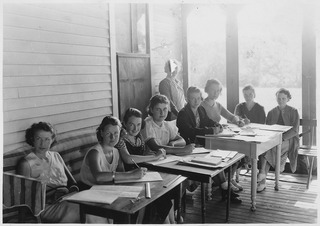External links
| | This article about a war film is a stub. You can help Wikipedia by expanding it. |
| Training Women For War Production | |
|---|---|
| Narrated by | Eleanor Roosevelt |
| Cinematography | D. Nichols and F.B. Hyde |
| Distributed by | National Youth Administration |
Running time | 7 minutes |
| Country | United States |
| Language | English |
Training Women for War Production is a short film.
Eleanor Roosevelt, who was already a big supporter of the National Youth Administration, introduced and narrated this short film for the NYA during the Second World War.
The film opens with Mrs. Roosevelt sitting on a couch - a pink vase is placed in front of her to accentuate the color - and she tells the audience that during the emergency the NYA was changing its gears somewhat, to help the war effort. Whereas the NYA used to provide programs for youth, now it was concentrating on training young girls for war work. Then various scenes are shown explaining women's roles in various capacities, first focusing on traditionally feminine areas such as sewing parachutes and uniforms, nursing, and clerical work. However the latter part of the film increasingly shows the industrial side of war production, particularly the manufacturing of ammunition and weapons.
African-American women's efforts are highlighted in the film. Mrs. Roosevelt, an early champion of Civil Rights, noting that "Negro girls have an important role in war work."

William Wyler was a Swiss-German-American film director and producer who won the Academy Award for Best Director three times, those being for Mrs. Miniver (1942), The Best Years of Our Lives (1946), and Ben-Hur (1959), all of which also won for Best Picture. In total, he holds a record twelve nominations for the Academy Award for Best Director.
The history of the United States from 1918 through 1945 covers the post-World War I era, the Great Depression, and World War II. After World War I, the U.S. rejected the Treaty of Versailles and did not join the League of Nations.

Victory gardens, also called war gardens or food gardens for defense, were vegetable, fruit, and herb gardens planted at private residences and public parks in the United States, United Kingdom, Canada, Australia and Germany during World War I and World War II. In wartime, governments encouraged people to plant victory gardens not only to supplement their rations but also to boost morale. They were used along with rationing stamps and cards to reduce pressure on the public food supply. Besides indirectly aiding the war effort, these gardens were also considered a civil "morale booster" in that gardeners could feel empowered by their contribution of labor and rewarded by the produce grown. This made victory gardens a part of daily life on the home front.

Mary Jane McLeod Bethune was an American educator, philanthropist, humanitarian, womanist, and civil rights activist. Bethune founded the National Council of Negro Women in 1935, established the organization's flagship journal Aframerican Women's Journal, and presided as president or leader for myriad African American women's organizations including the National Association for Colored Women and the National Youth Administration's Negro Division. She also was appointed as a national adviser to president Franklin D. Roosevelt, whom she worked with to create the Federal Council on colored Affairs, also known as the Black Cabinet. She is well known for starting a private school for African-American students in Daytona Beach, Florida. It later continued to develop as Bethune-Cookman University. Bethune was the sole African American woman officially a part of the US delegation that created the United Nations charter, and she held a leadership position for the American Women's Voluntary Services founded by Alice Throckmorton McLean. For her lifetime of activism, she was deemed "acknowledged First Lady of Negro America" by Ebony magazine in July 1949 and was known by the Black Press as the "Female Booker T. Washington". She was known as "The First Lady of The Struggle" because of her commitment to gain better lives for African Americans.

Oliver "Daddy" Warbucks is a fictional character from the comic strip Little Orphan Annie. He made his first appearance in the New York Daily News in the Annie strip on September 27, 1924. In the series he is said to be around 52 years of age.

The National Youth Administration (NYA) was a New Deal agency sponsored by Franklin D. Roosevelt during his presidency. It focused on providing work and education for Americans between the ages of 16 and 25. It operated from June 26, 1935 to 1939 as part of the Works Progress Administration (WPA) and included a Division of Negro Affairs headed by Mary McLeod Bethune who worked at the agency from 1936 to 1943. Following the passage of the Reorganization Act of 1939, the NYA was transferred from the WPA to the Federal Security Agency. In 1942, the NYA was transferred to the War Manpower Commission (WMC). The NYA was discontinued in 1943.

Mrs. Miniver is a 1942 American romantic war drama film directed by William Wyler, and starring Greer Garson and Walter Pidgeon. Inspired by the 1940 novel Mrs. Miniver by Jan Struther, the film shows how the life of an unassuming British housewife in rural England is touched by World War II. Produced and distributed by Metro-Goldwyn-Mayer, the film features a supporting cast that includes Teresa Wright, Dame May Whitty, Reginald Owen, Henry Travers, Richard Ney, and Henry Wilcoxon.

The United States home front during World War II supported the war effort in many ways, including a wide range of volunteer efforts and submitting to government-managed rationing and price controls. There was a general feeling of agreement that the sacrifices were for the national good during the war.

During active American involvement in World War II (1941–45), propaganda was used to increase support for the war and commitment to an Allied victory. Using a vast array of media, propagandists instigated hatred for the enemy and support for America's allies, urged greater public effort for war production and victory gardens, persuaded people to save some of their material so that more material could be used for the war effort, and sold war bonds. Patriotism became the central theme of advertising throughout the war, as large scale campaigns were launched to sell war bonds, promote efficiency in factories, reduce ugly rumors, and maintain civilian morale. The war consolidated the advertising industry's role in American society, deflecting earlier criticism. The axis leaders were portrayed as cartoon caricatures to make them appear foolish and idiotic.

Aubrey Willis Williams was an American social and civil rights activist who headed the National Youth Administration during the New Deal.

Anna Eleanor Roosevelt was an American political figure, diplomat, and activist. She served as the first lady of the United States from 1933 to 1945, during her husband President Franklin D. Roosevelt's four terms in office, making her the longest-serving first lady of the United States. Roosevelt served as United States Delegate to the United Nations General Assembly from 1945 to 1952. President Harry S. Truman later called her the "First Lady of the World" in tribute to her human rights achievements.

My Day was a newspaper column written by First Lady of the United States Eleanor Roosevelt (ER) six days a week from December 31, 1935, to September 26, 1962. In her column, Roosevelt discussed issues including civil rights, women's rights, and various current events. This column allowed ER to spread her ideas, thoughts, and perspectives on contemporary events to the American public through local newspapers. Through My Day, Roosevelt became the first First Lady to write a daily newspaper column. Roosevelt also wrote for Ladies Home Journal, McCall's, and published various articles in Vogue and other women's magazines.

The Woman's Land Army of America (WLAA), later the Woman's Land Army (WLA), was a civilian organization created during the First and Second World Wars to work in agriculture replacing men called up to the military. Women who worked for the WLAA were sometimes known as farmerettes. The WLAA was modeled on the British Women's Land Army.

The War Against Mrs. Hadley is a 1942 American drama film directed by Harold S. Bucquet and starring Fay Bainter and Edward Arnold. The plot depicts how wealthy society matron Stella Hadley selfishly refuses to sacrifice her family or material comforts during World War II, until tragedy strikes an old rival. The script by George Oppenheimer was nominated for an Academy Award for Best Original Screenplay.
World War II changed the possibilities for animation. Prior to the war, animation was mostly seen as a form of family entertainment. The attack on Pearl Harbor was a turning point in its utility. On December 8, 1941, the United States Army began working with Walt Disney at his studio, stationing Military personnel there for the duration of the war. The Army and Disney set about making various types of films for several different audiences. Most films meant for the public included some type of propaganda, while films for the troops included training and education about a given topic.

Women in the Second World War took on many different roles during the War, including as combatants and workers on the home front. The Second World War involved global conflict on an unprecedented scale; the absolute urgency of mobilizing the entire population made the expansion of the role of women inevitable, although the particular roles varied from country to country. Millions of women of various ages were injured or died as a result of the war.

The She-She-She Camps were camps for unemployed women that were organized by Eleanor Roosevelt (ER) in the United States as a counterpart to the Civilian Conservation Corps (CCC) programs designed for unemployed men. ER found that the men-only focus of the CCC program left out young women who were willing to work in conservation and forestry and to sign up for the six-month programs living away from family and close support. She lobbied for a sister organization to the CCC that would be for young women. Eleanor Roosevelt proposed that this would consist of camps for jobless women and residential worker schools. The She-She-She camps were funded by presidential order in 1933. Labor Secretary Frances Perkins championed one such camp after ER held a White House Conference for Unemployed Women on April 30, 1934, and subsequently ER's concept of a nationwide jobless women's camp was achieved. While the public largely supported the New Deal programs and the CCC was a huge success, the women's version barely topped 5,000 women annually by 1936 and overall served 8,500 as a result of ER's support.
Food Will Win the War is an American short animated film produced by Walt Disney Studios and released on July 21, 1942, seven months and two weeks after the December 7, 1941 attack on Pearl Harbor. The 6-minute short was one of a series of animated films produced by Disney during the war as part of a propaganda campaign. The animation was produced on order of the Department of Agriculture, first and foremost to educate about the importance of American agriculture in the war effort and also, to offset fears and panic of Americans who thought too many supplies were being sent overseas. The film was a morale boosting production, in the hope of improving public mood and opinion about sacrifice for the war effort.
The Barelas Community Center is a historic community center in the Barelas neighborhood of Albuquerque, New Mexico. It was built from 1940 to 1942 by the National Youth Administration (NYA), a New Deal agency which provided jobs and vocational training for young Americans. The NYA completed the Heights Community Center in 1940 and immediately started work on a second center, in cooperation with the League of United Latin American Citizens (LULAC), to serve the majority-Hispanic Barelas neighborhood. It was dedicated during the LULAC national convention in June, 1942. Heights and Barelas were the first two community centers in the city, and both are still in use as of 2021.